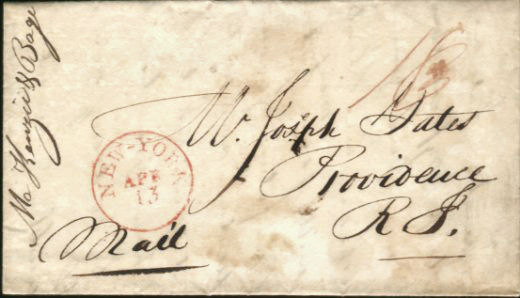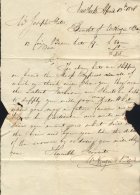![]()
Postal History Introduction
Stampless
Covers
1846
to 1900 Issues
1901-1950
Issues
1951-2003
Issues
Cancels
&
Miscellaneous
Postal
Stationery
Post
Cards
Air
Mail
First
Day &
Event Covers
Parcel Post/Special Delivery
Registered & Official Mail
Commercial & Advertising
Revenue & Postage Due
Wildlife & Game Issues
Complete List of RI Issues
|
Rhode Island Stampless
Covers & Letters |
|||
|
|||
|
The rate of 183/4 cents is the correct rate for a single sheet letter weighing less than one ounce and traveling a distance between 150 and 300 miles, (New York to Providence). The rate was set by the Postal Act of March 3, 1825 and became effective on May 1, 1825. This zone rate remained in effect until July 1, 1845. Previously this zone rate set in 1816 was 181/2 cents. NOTE: The reason for the rate change was that during the early 19th century the Spanish Real was still in wide usage. The Real was equivalent to $1.00 in U.S. currency and could be divided into 8 bits, (pieces of eight). One (1) bit was equal to 121/2 cents and 183/4 cents was the equivalent of 11/2 bits. (This is also the origin for the term 2 bits equaling a quarter.) |
|||
|
The letter was torn when the original recipient broke the seal and parts of it were lost, however I was able to transpose the majority of it and it is reproduced below. The letter is an invoice for 12 beaver hats and also asks for instructions on the type and style that Mr. Yates prefers for the next shipment. The seller, Kengie & Bowe also states that they can supply an additional 4 hats. The letter and a background history of beaver hats and the beaver trade follow below. New York April 13th . 1826
Mr. Joseph Yates,
|
|||
|
I found one reference to a Joseph Yates, Hatter listed in the Providence Directory for 1836/37. Felt Hats made from Beaver Fur were very popular in most of Europe and the Eastern United States from the mid-1500s to around 1850. By the year 1600, Beavers had been trapped out and were close to extinction in Europe. The Fur Trade now depended completely on North American furs to keep the trade alive. Beaver Pelts were much sought after in the making of Felt Hats. This was because Beaver fur had little barbs on the ends, which when pressed would interlock to make a solid fabric. The process was known as felting. There were two types of Beaver pelts sought in North America known as Coat and Parchment. Coats were pelts that had been previously worn by Native Americans and Parchment were pelts that had been recently trapped for the trade. Coat Pelts were the favored type, because in wearing them the course outer fur was worn down leaving only the soft inner hair, which was easier to felt. During and shortly after the War of 1812; the American fur trade was inactive and it wasn't until John Jacob Astor established his American Fur Company at Saint Louis in 1822 that the trade began to flourish again. During the mid-1830s, Silk Hats became the fashionable hat to own and the demand for beaver pelts diminished. This was just as well, for by this time, the Beaver was on the edge of extinction in North America as it had been earlier in Europe. |
|||

RI Historical
Society
Introduction
Stampless I
Stampless II
Stampless III
Stampless IV
Stampless V
Stampless VI
Brown & Ives Letters
The Hazard Family Letters
Joseph Tillinghast
Free Franked Letters
DeWolf Family Letters
Recently Added Pages

